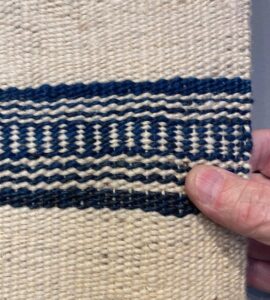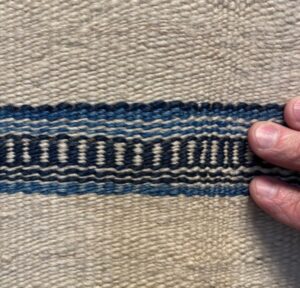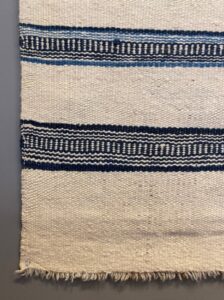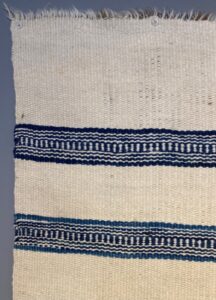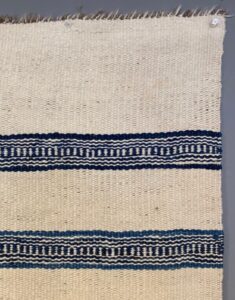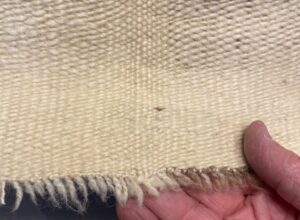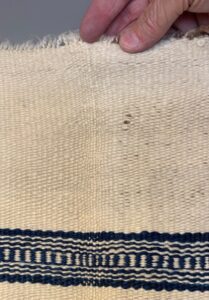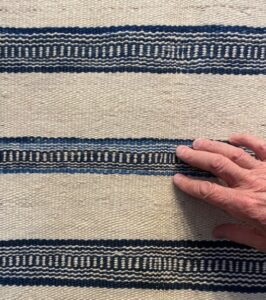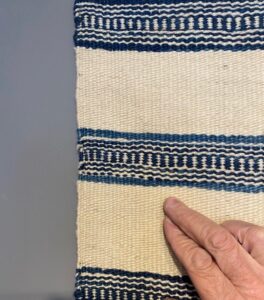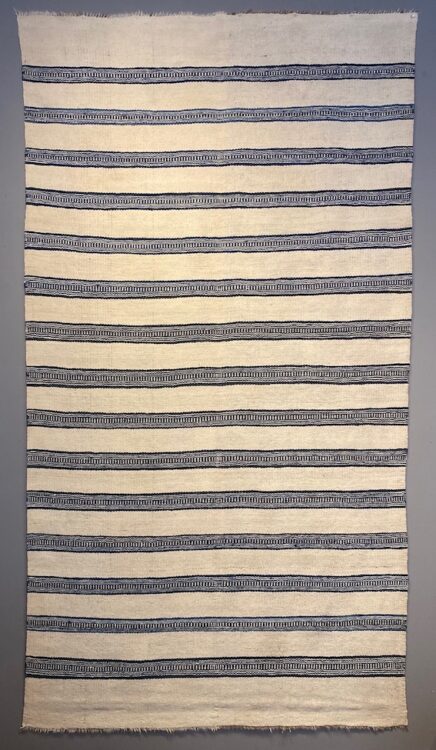
An Early and Rare Rio Grande Blanket
- by Jamie Compton
- in A closer look... New Gallery Item
- posted May 19, 2023
This Rio Grande blanket is one of the most beautiful examples I’ve had the fortune of finding. It’s early, it’s simple, it’s complex and it speaks to my aesthetic in the world of exceptional blankets. Let me speak briefly here about the qualities that make this the case.
It is woven of only two colors; the natural white of the churro sheep, and the natural white dyed with indigo blue. It’s most unusual in the exclusive use of the indigo banding systems repeating a total of 15 times. These indigo bands are assemblages of weft beading. The outer edges of the band are solid indigo. In from there are systems of two weft picks of white followed by two weft picks of blue, creating “wavy” stripes. These are done in sets of three. The wavy stripes frame the interior vertical beading at the center where beading creates small, vertical bands of white and blue alternating with each other. This sort of beading system is most known in Navajo textiles and not with Rio Grande blankets. It is this, in part, that I consider this blanket woven by a Navajo on a Spanish Colonial horizontal loom.
The above two detailed photos show an indigo beaded band with “wavy” lines along with vertical beading in the center. The second photo shows the lighter indigo band, second from the top.
It’s interesting to note, on a finer scale, the variation of indigo found within these beaded bands. Thirteen of these bands are variations of mostly dark indigo mixed with some lighter indigo. The remaining two bands are done in a consistently lighter indigo blue. These two bands are both found one band in from the ends. While it’s common for blankets to have a repeating system like this, it’s unusual for the outer bands to vary like they do here. Past examples show that the next most common type of banded system is one where the center is made different from the rest. It is this unique design feature that has me considering a Navajo as the weaver since the Spanish are more likely to adhere to a pattern and stick with it. My bias can’t help but see this weaver as a sophisticated individual.
The first two photos show the lightness in indigo of the second band from the bottom of the blanket. The second set shows the top of the blanket and the lightness of the second band.
It’s unusual for a Rio Grande blanket to have no brown wool in it. The only wool approaching brown would be the use of a light tan colored wool found only in the warps. A number of the warps are a mixture of white and tan wool. The blanket is woven as one piece with grouped warps in the center. A narrow, horizontal loom was used with the warps doubling up underneath the top layer of warps to allow for the entire blanket to be woven as one piece. More common would be to weave two separate halves and connect the two creating a seam down the center. Instead of a seam we have grouped warps.
Both of these photos show the opposite ends of the blanket at its center. The center of the photo shows the grouped warps. The first photo also shows clearly the use of light tan wool in the warps on the right side of the blanket. This is a little harder to see in the second photo, as my hand is hiding much of the warp knots at this end.
The earlier date is suggested for several reasons. First and second, the narrowness of the loom and the coarse weave of the warps. The earlier looms were more primitive and more narrow. The blanket is 47 inches wide, which means the loom was just shy of 24″. Generally, later blankets are wider as the looms got wider with time. The reeds on the earliest looms, which determine the warp spacing, were natural material later becoming replaced with steel. The difference here is that the earlier blankets show fewer warps per inch compared to later metal reeds that allowed for a higher count of warps per inch. The blanket has 6 warps per inch, which is the lower end of warps per inch. Thirdly, the wool is churro, the original wool brought over to North America by the Spaniards. Fourthly, the high degree of variation of indigo color found throughout this blanket, from nearly black to a light blue, suggests that the indigo was made in small batches, perhaps limited by the container for the dye. Lastly, and mostly notably, the simple and original design suggests an earlier aesthetic that did not carry over into the later styles, as no blanket I have ever seen nears this sort of pattern. Put all together, one might look at a broad range from 1800 to 1860 as the window when this could have been made.
I can’t look at this blanket enough. It simultaneously satisfies while keeping me perplexed. This blanket is currently on display at the gallery. If you’re around, I encourage you to drop by and see this for yourself.

